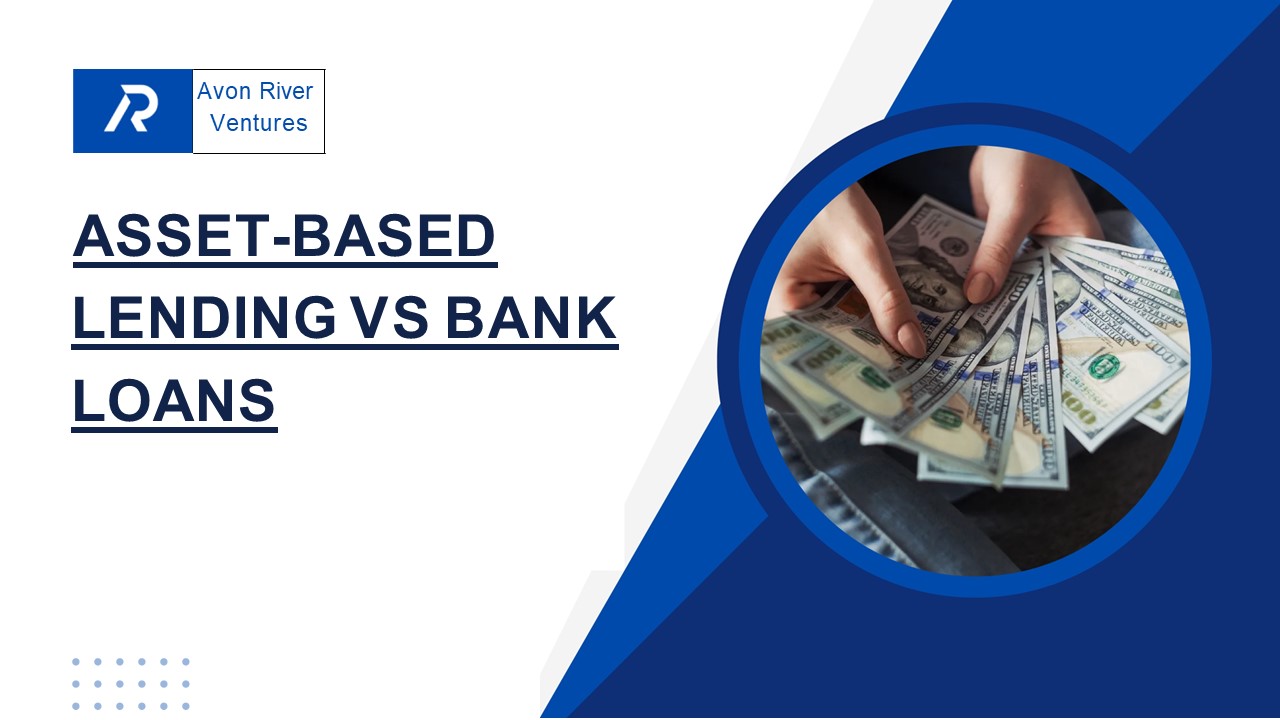ASSET-BASED LENDING VS BANK LOANS
Title:
ASSET-BASED LENDING VS BANK LOANS
Description:
Assets are things like property or equipment. Knowing how each loan works will help you choose the best one for your situation. Let’s learn more about asset-based lending vs. bank loans with the help of this ppt. –
Number of Views:2
Title: ASSET-BASED LENDING VS BANK LOANS
1
Avon River Ventures
- ASSET-BASED LENDING VS BANK LOANS
2
Understanding Asset-Based Lending
Asset-based lending is a way to get a loan using
assets you own as collateral. The lender looks at
assets like equipment, accounts receivable,
inventory, and real estate to approve the loan.
They offer money based on the value of those
assets. With asset-based lending, the loan
depends on your assets rather than your
business's credit score or financials. This type
of financing is often used by small and
medium-sized companies that need money quickly
for short-term needs. It provides fast access to
capital based on assets on hand.
I ----
I --
3
How Asset-Based Lending Works?
To get an asset-based loan, you will go through
an appraisal process. The lender will evaluate
your assets to determine how much they can loan
against their value. They will also assess your
ability to pay back the loan through your
business finances and operations. The loan
agreement will outline the collateral assets
being used, the loan amount, fees, and repayment
terms. The lender takes a security interest in
your assets as collateral. If you default, they
can seize these assets.
4
Benefits of Asset-Based Lending
- Asset-based lending offers several advantages,
especially for small and mid-sized companies. - Fast Approval
- Because asset-based loans depend on assets rather
than credit, they can often be approved quicker
than traditional bank loans. This speedy access
to capital can help companies meet immediate
funding needs. - Flexible Use of Funds
- You have flexibility in how to use asset-based
financing. The money can be used for varied
operating expenses, equipment purchases,
renovations, marketing, payroll, or other
business needs.
5
Debt Consolidation
These loans allow you to roll multiple debts into
one loan and pay off higher-interest credit cards
or loans. This streamlines payments and reduces
interest costs. Higher Credit Limits Since you
borrow against the value of your business assets,
you can sometimes get larger loan amounts than
with conventional bank lending limits. Understandi
ng Traditional Bank Loans Traditional bank loans
are a common way for small businesses to get
financing. These loans come from banks and allow
you to borrow money that must be repaid over time
with interest.
6
How do Bank Loans Work?
With a bank loan, you borrow a set amount of
money from a bank and pay it back in regular
monthly installments. The loan will have an
interest rate, term length, and repayment
schedule outlined. Banks carefully evaluate your
business before approving a loan. They look at
your business plan, finances, credit score,
and collateral. The loan is backed by assets you
pledge if you can't repay.
7
Benefits of Bank Loans
Traditional bank loans offer small business
owners some key advantages Lower Rates Because
banks see small business loans as less risky,
they typically offer lower interest rates than
alternative lenders. This results in greater
savings over the loan term. Longer Repayment
Period Banks often provide longer repayment
schedules of 5-10 years for small business loans.
The extended timeline gives your business more
flexibility. Building Credit Taking out
and repaying a bank loan helps demonstrate your
business is creditworthy. This supports improved
credit access in the future.
8
Key Differences Asset-Based Lending vs.Bank Loans
- When evaluating financing options, it's important
for small business owners to understand the core
differences between asset-based lending and
traditional bank loans. - Basis of Approval Asset-based loans are backed
by the value of your business assets like
accounts receivable or - .fil1.Y.iP-ment loan. Bank loans rely on your
business and personal creditworthiness. - Flexibility Asset-based lending allows for more
customizable loan amounts and terms tailored to
your needs. Bank loans offer more standardized
terms. - Interest rates The interest charged is usually
higher with asset-based lending compared to bank
loan rates. - Speed of funding Asset-based loans can often be
approved and funded in days or weeks since they
focus on assets rather than credit. Bank loans
involve extensive underwriting and paperwork. - While both offer access to capital, the two have
distinct approval processes, terms, costs,
and timelines.
9
Conclusion
Getting money is so important for companies to
grow and run each day. But getting financing can
be really hard, especially for small and medium
companies. Getting financing quickly and easily
is crucial for companies to keep growing and
running daily operations. Avon River Ventures
aims to make capital accessible by providing
customized financing solutions tailored to each
unique client. At Avon River Ventures, we serve
as a trusted liquidity partner for the long term.
Our experienced team assesses each client's
specific situation to help them get the optimal
financing.
10
Contact Us
Phone 647-609-9086 Website www.avonriverventures.c
om Email con nect_at_avonriverventures.com































